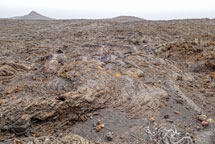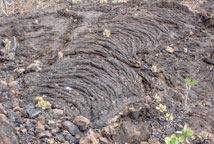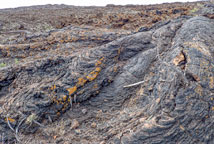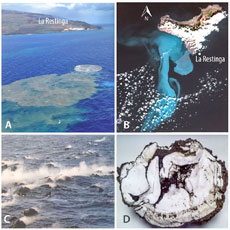|
Home
Page 1/6
Page 2/6
Page 3/6
Page 4/6
Page 5/6
Page 6/6 (this page)
|
El Hierro, the youngest Canary.
Island of landslides
webpage 6/6
Text: Annemieke van Roekel, geoscience journalist
www.vuurberg.nl.
This article was first published in Gea Magazine (September 2022).
Rope lava
The Centro de Interpretación del Geoparque is located on the road
to the southernmost town of La Restinga,
in the middle of a lava field with beautiful structures of rope lava, lava tunnels and cones
(fig. 16-18).
Spectacular film footage is shown of floating, steaming rocks, from
10 to 40 cm in diameter, released during the most recent eruption in 2011,
5 km off the coast of La Restinga (Fig. 19).
Comparative examination of the seafloor shows that a 100-m-high new cone was formed
on the flank of the southern submarine ridge.
There appeared to be two types of floating rocks: hollow "lava balloons" of basalt and
white frothy "xeno-pumice:" vesicle-rich volcanic bombs filled with glassy, highly veined material,
similar to pumice, to which they owe their buoyancy. These floating rocks are a rarity in volcanology.



Fig. 16-18. "Lajiales" (fairly flat lava-covered areas) with ropy lava
structures surround the Geopark Information Center. Photo's: Annemieke van Roekel.
Restingolites
These rocks often sank after the pores were filled with water; many also washed ashore.
They were picked up and treasured by the Herreños, the inhabitants of El Hierro.
The white 'restingolites', as they are locally called, are no longer a mystery.
Based on mineralogy, chemistry and isotopic composition, they are interpreted as xenoliths,
derived from pre-vulcanic sediments on the ocean floor (Troll et al., 2012). They contain quartz,
which is unusual for the volcanic rocks of El Hierro, and recently researchers have
found nannofossils of Cretaceous and Jurassic age in them.
Volcanologists believe that these sediments, lying directly
on the pillow lavas (layer 1 of the oceanic crust) reacted with magma and were
transported upward while degassing (Fig. 19).
The latest eruption at La Palma (in Sept-Nov 2021) also encountered xeno-pumice.
Volcanologist/ petrologist Valentin Troll and his Spanish colleagues are currently analyzing
the mineralogy and genesis of this material.

Fig. 19. Images of the undersea eruption at La Restinga in 2011.
A. The green-colored seawater, locally called "La mancha" ("the stain"),
was the result of volcanic gases dissolved in sea water and suspension. Photo: Guardia Civil.
B. Satellite image of the gas plume. Photo: RapidEye. C. Degassing floating "lava balloons"
and xeno-pumice. Photo: Guardia Civil. D. Xeno-pumice. A-D in: Carracedo & Troll, 2016 (fig. 2.17A-D).
With kind permission.
References and reading suggestions
- Website El Hierro Geoparque.
- Carracedo, Juan Carlos & Valentin R. Troll (2016). The geology of the Canary Islands.
Elsevier.
- Carracedo, Juan Carlos, Valentin R. Troll, Kirsten Zaczek, Alejandro Rodríguez-González, Vicente
Soler, Frances M. Deegan (2015). The 2011-2012 submarine eruption off El Hierro, Canary Islands:
New lessons in oceanic island growth and volcanic crisis management. Earth-Science Reviews 150.
- Masson, D.G. (1996) Catastrophic collapse of the volcanic island of Hierro 15 ka ago and the
history of landslides in the Canary Islands. Geology 24(3).
Page 1/6
Page 2/6
Page 3/6
Page 4/6
Page 5/6
Page 6/6
Copyright: Annemieke van Roekel
Last update: 28 December, 2022
|